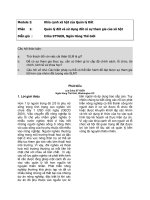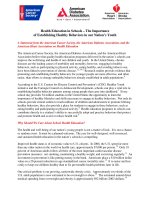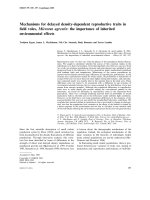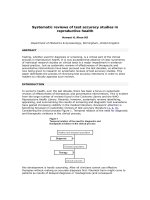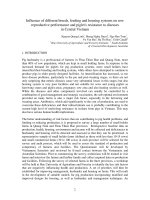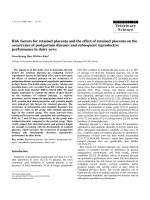Importance of micro minerals in reproductive performance of farm animals
Bạn đang xem bản rút gọn của tài liệu. Xem và tải ngay bản đầy đủ của tài liệu tại đây (133.09 KB, 6 trang )
Int.J.Curr.Microbiol.App.Sci (2018) 7(7): 3584-3589
International Journal of Current Microbiology and Applied Sciences
ISSN: 2319-7706 Volume 7 Number 07 (2018)
Journal homepage:
Review Article
/>
Importance of Micro Minerals in Reproductive
Performance of Farm Animals
Sandeep Uniyal1*, K. Ashwin1, Alok Mishra1, Jatin Kumar Sahoo1 and Varsha Paladan2
1
Division of Animal Nutrition, ICAR-IVRI, Izatnagar, Bareilly, U.P -243122, India
2
Veterinary Bacteriology Division, ICAR-IVRI, Izatnagar, Bareilly, U.P, India
*Corresponding author
ABSTRACT
Keywords
Health,
reproductive
performance Micro
minerals, Enzymes,
Antioxidant
Article Info
Accepted:
26 June 2018
Available Online:
10 July 2018
Micro minerals are those which are required in minute amount (<100mg/Kg DM) for
optimum health and reproductive performance of animals. Various minerals (copper,
selenium, manganese, iodine, zinc, and chromium) can influence reproductive
performance of animals. It has been suggested that deficiency of micronutrients alter
reproductive performance of animals by reducing the activity of rumen microflora,
reduction in enzyme activity affecting energy and protein metabolism, synthesis of
hormones, antioxidants function and the integrity of rapidly dividing cells within the
reproductive system. Most of the feeds and fodder available in India are deficient in one or
more micro elements so there is need of supplementation of micro minerals in the ration of
farm animals either in the form of mineral mixture or based on the status of soil, feed and
fodder of particular region as an area specific mineral mixture.
Introduction
Bennetts and Chapman (1937) were the first
who established the link between nutrition and
reproduction they found that swayback in
lambs occur as a result of deficiency of
copper. Micro minerals deficiency most
commonly occurs in high production animals
ultimately leading to poor reproductive
performance. These minerals are required in
minute amount and excess feeding of some of
these may show toxicity symptoms. Twenty
two micro minerals are required for optimum
reproductive health of farm animals the
important one includes copper, cobalt,
manganese, selenium, iodine, zinc, chromium.
These minerals are important component of
various metallo- enzymes, enzyme cofactors
and some of them are integral part of enzymes
related to neutralization of reactive oxygen
species (ROS) and thereby prevent free radical
induced damage of lipids membranes. Some
of these are component of hormones and thus
play important role in metabolism of
macromolecules (carbohydrate, protein and
nucleic acid) and any alteration in the level of
these minerals may affect the production of
reproductive and other hormones. Low level
of these micro minerals in the ration may
affect embryonic development, post-partum
3584
Int.J.Curr.Microbiol.App.Sci (2018) 7(7): 3584-3589
recovery and over all fertility in the female
animals and in male animals it may change
spermatogenesis and reduce libido. Most of
the unconventional feeds are deficient in
micro minerals and are likely to accentuate
reproductive problems.
Selenium (Se)
Selenium is an essential trace mineral and
plays an important role in various biological
reactions like antioxidant defense by the virtue
of the important component of an enzyme
glutathione peroxidases and selenoproteins
(Allmang and Krol, 2006) it also required for
optimum fertility in both males and females,
conversion of thyroid hormone in to active
form and immunomodulation (Spallholz,
1990) requirement selenium is generally very
low 0.1-0.3 ppm for most of the species. Se
occurs in inorganic and organic forms in
nature. Inorganic form found as selenite
(Se4+), selenate (Se6+), and selenide (Se2−) and
these forms mainly selenite or selenite are
obtained by plants from soil to synthesize Secontaining amino acids. If soils is deficient in
Se results in decrease level of Se in plants.
Therefore, the supplementation of Se in
animal feed is necessary in areas where levels
of soil Se are low. Selenium and vitamin E
exert sparing effect on each other and both are
having potent antioxidant function and protect
biological system from oxidative degradation
there by improve reproductive potential of
animals In early studies it was shown that
selenium and vitamin E injections reduced the
incidence of retention of fetal membrane it
was also observed that supplementation of
selenium with vitamin E reduces the incidence
of metritis and cystic ovaries when
administered prepartum. Selenium in males
essential for normal spermatozoa development
it is incorporated in the sperm mitochondria
capsule and may thus affect the behavior and
function of the spermazoon. Moeini et al.,
(2009) reported that supplementation of 20-40
ml of selenium and vitamin E injection (0.5
mg Se and 50 IU of DL alpha tocopheryl
acetate/ml) to the heifer 4 and 2 week before
calving results in decrease in service pre
conception and open days in the treated
groups, however, gestation length remain
same among the groups. Ganie et al., (2014)
observed that supplementation of 0.2 ppm
sodium selenite in the diet of murrah heifer for
120 day results in reduction in age at first
calving and higher conception rate as
compared to control. Similarly, Arechiga et
al., (1998) reported that service per conception
and service period were significantly
decreased in the dairy cows administered with
single intramuscular injection of vitamin E
(200 mg)and sodium selenite (50 mg)postpartum. Qureshi et al., (2010) reported that
increase in conception rate and estrus rate
following 50 mg selenium administration in
buffaloes this may be due to the positive effect
of selenium on post-partum uterine involution
results in improvement of reproductive
performance.
Khatti et al., (2017) reported that
supplementation of Se (0.3 mg/kg DM) and
Vitamin E (80 IU/kg DM) along with 20%
additional allowance for energy to the advance
pregnant cross bred cow results in
significantly higher pregnancy rate and early
resumption of postpartum estrus in treated
animals as compared to control. Kamada
(2017) reported that postpartum plasma
progesterone concentrations was higher in
selenium yeast (300 mg Se, 10 g yeast)
supplemented Holstein cow the control.
Zinc
Zinc (Zn) is an essential trace element
important for every living being (Suttle,
2010). It is an important component of various
metalloenzymes and activator of more than
300 enzymes in the animal body (Salim et al.,
2012). Zinc acts as an essential component of
3585
Int.J.Curr.Microbiol.App.Sci (2018) 7(7): 3584-3589
antioxidant defense system (Bao and Choct,
2009), plays an important role in thyroid
metabolism (Mullur et al., 2014) and is also
required for normal activity of immune system
(Tsai et al., 2016).It play important role in
configuration of RNA and DNA by formation
of zinc fingers which is essential for the
binding of steroid receptor complex to DNA
(Freedman, 1992). Zn influence pregnancy by
modulating the action of insulin-like growth
factors (IGFs) at the cellular level. Insulin-like
growth factors are known to be potent
stimulators of tissue differentiation and cell
proliferation. These growth factors are present
in high levels within the uterus of several
livestock species during early pregnancy (Ko
et al., 1991) and may be important in uterine
remodelling during the time of embryonic
implantation (IGF-I) and fetal development
(IGF-II), as well as for conceptus growth in
general. In male testes have higher amount of
zinc as compared to liver and kidney. I t has
been observed that zinc deficiency can cause
severe damage to the testes such as atrophy of
the testicular tubules and the inhibition of
spermatid differentiation. Abdel et al., (2011)
reported that supplementation of different
levels of inorganic zinc oxide (50-150 ppm) in
Baladi ewe significantly increased the
incidence of oestrus, pregnancy, lambing rates
and resulted in shorter onset of oestrus as
compared to the control group.Kundu et al.,
(2014) reported that supplementation of 50
and 100 ppm zinc oxide to Teressa goat results
insignificantly higher incidence of oestrus
(33%), pregnancy rate (12%), kidding rate
(5%) and resulted in shorter onset (8 days) of
oestrus as compared to the control.
Copper
Cu first shown to essential for growth and Hb
formation in 1928 It is also a critical
functional component of a number of enzymes
known as cuproenzymes (cytochrome c
oxidase,
Superoxide
dismutase,
Ceruloplasmin) (Coppen et al., 1998). It has
been established that Cu is related to synthesis
and secretion of the hypophysiary hormones,
modulating the capacity for the liberation of
the luteinizing hormone (LH). (Corbellini,
1998). The administration of gonadotrophic
releasing hormone (GnRH) in rats with normal
levels of Cu increased the liberation of LH and
follicle stimulating hormone (FSH) from the
hypophysis, when compared to hypocupremic
animals, probably due to Cu stimulating the
GnRH receptors in the hypophysis (Kochman
et al., 1997). However, it also has a role as an
antioxidant, which may be an importance
factor
in
maintaining
reproductive
performance. Juan et al., (2012) reported
supplementation of Cu EDTA in hypocupric
animals resulted in higher onset of estrus and
pregnancy rate this improvement in the
reproductive performance is mainly due to
increase in gonadal hormonal output under the
influence of GnRH.
Manganese
Fifth most abundant metal on earth shown to
be essential for growth and fertility it was first
classified as an essential trace element in
1931. A deficiency of Mn results in poor
growth and impaired reproduction, which is
characterized by testicular atrophy in males
and impaired ovulation in females. It play
important role in reproductive cycle of
animals by virtue of its role in steriodogenesis
(cofactor for an enzymes mevalonate kinase
and fernesyl pyrophosphate synthase required
for cholesterol biosynthesis) Mn may have a
role in initiating estradiol secretion by the
conceptus as the signal for pregnancy
recognition in pigs. Alternatively, Mn may
play a role in progesterone secretion because
concentrations of Mn in the CL of ewes
increased between 4 and 11 days (Hurley and
Doane, 1989).
3586
Int.J.Curr.Microbiol.App.Sci (2018) 7(7): 3584-3589
Iodine
Necessary for thyroid hormone synthesis that
regulate BMR and energy metabolism
Reproductive disorder in iodine deficiency
due to thyroid gland dysfunction in the dam,
embryo or fetus, which in the last two can
cause embryonic death, abortion, stillbirth or
weak goitrous calves (suttle, 2010). Iodine is
required for thyroxine synthesis which is a
general metabolic regulator and, in particular,
a regulator of mitochondrial activity and lack
of of thyroxine is associated with non-specific
signs of poor growth, loss of libido and
inhibition of oestrous behaviour hence affect
the reproductive performance of animals.
Sargison et al., (1998), reported that
supplementation of iodine to ewes before
mating increase the twining rate this occur
due to increase in ovulation following iodine
supplementation.
Chromium
Cr in form of dinicolinic acid-glutathione
complex (GTF) - vital for carbohydrate
metabolism chromium has an improving
effect on insulin binding and increases the
number of insulin receptors on the cell surface
and sensitivity of pancreatic β-cells together
with an overall increase of insulin-sensitivity
(Anderson, 1997).The mechanism of effect of
Cr on reproduction functions has not been
known. One of the theories (Lindemann,
1996) assumes reproduction can be affected
by changing sensitivity to insulin. Most
attention has been devoted to studying the
effect of Cr on reproduction in pigs. Cr
supplementation to sow during the
reproduction cycle has had a positive effect
on the size of the litter at birth as well as the
weight at weaning (Lindemann et al., 1995).
Also retention of foetal membranes was
significantly reduces in dairy cows
supplemented with chromium picolinate this
may be due to reduction in concentration of
cortisol (Villalobos et al., 1997).
In conclusion, trace minerals have profound
effect on fertility of animals these are required
for synthesis of reproductive steroid
hormones and optimum cellular enzyme
function which are necessary for reproductive
efficiency regular feeding of these trace
minerals is very important for the
achievement of opium reproductive health of
animals.
References
Bennetts, H.W., Chapman, F.E. 1937. Copper
deficiency in sheep in Western
Australia: a preliminary account of the
aetiology of enzootic ataxia of lambs
and an anaemia of ewes. Australian
Veterinary Journal.13:138- 149.
Allmang, C. and Krol, A. 2006.Selenoprotein
synthesis: UGA does not end the
story. Biochemie.88, 1561–1571.
Arechiga
C.F.,
Vazquez-Flores
S.,
Hernandez-Ceron J., Porras P.,
McDowell L.R. and Hansen P.J.
1998.Effect of injection of beta
carotene or vitamin E and selenium on
fertility of lactating dairy cow.
Theriogenology. 50: 65-76.
Bao, Y.M. and Choct, M. 2009. Trace mineral
nutrition for broiler chickens and
prospects of application of organically
complexed trace minerals: a review.
Animal Production Science.49: 269–
282.
Coppen D.E. and Davies N.T.1988.Studies on
the roles of apotransferrin and
ceruloplasmin on iron absorption in
copper deficient rats using an isolated
vascularly- and luminally-perfused
intestinal preparation. British Journal
of Nutrition 60:361-373.
Corbellini
C.N.1998.
Influence
of
micronutrients in the fertility of dairy
cows] (part II).Revue de Médecinen
Vétérinaire. 79:231-236.
Freedman, L.P. 1992. Anatomy of the steroid
3587
Int.J.Curr.Microbiol.App.Sci (2018) 7(7): 3584-3589
receptor zinc finger region. Endocrine
Reviews. 13:129–145.
Gaine A. Ajaz., Baghel R.P.S., Mudgal V.,
Aarif O. and Sheikh G.C. 2014.Effect
of selenium supplementation on
reproductive
performance
and
hormonal profile in buffalo heifers,
Indian Journal of Animal.Research.
48(1): 27-30.
Hurley, W.L. and Doane, R.M. 1989. Recent
development in the roles of vitamins
and minerals in reproduction. Journal
of Dairy Science 72: 784–804.
Kamada, H. 2017.Effects of selenium-rich
yeast supplementation on the plasma
progesterone levels of postpartum
dairy cows. Asian-Australaian Journal
of Animal Science.30(3):347-354.
Khatti, A., Mehrotra, S., Patel, P.K.,, Singh,
G.,, Maurya, V.P.,, Mahla, A.S.,
Chaudhari, R.K., Das, G.K., Singh,
M., Sarkar, M., Kumar, H. and
Krishnaswamy,
N,
2017.
Supplementation of vitamin E,
selenium and increased energy
allowance mitigates the transition
stress and improves postpartum
reproductive performance in the
crossbred
cow.
Theriogenology.104:142-148.
Ko, Y., Lee, C.Y., Ott, T.L., Davis, M.A.,
Simmen, R.C.M., Bazer, F.W. and
Simmen,
F.A.1991.
Insulin-like
growth factors in sheep uterine fluids:
concentrations and relationship to
ovine trophoblast protein-1 production
during early pregnancy. Biology of
Reproduction. 45(1):135-42.
Kochman K., Gajewska A., Kochman H.,
Kozlowski H., Masiukiewicz E. and
Rzeszotarska B. 1997. Binding of
Cu2+, Zn2+, and Ni2+-GnRH
complexes with the rat pituitary
receptor. Journal of
Inorganic
Biochemsitry. 65: 277-279.
Kundu, M.S., De, A.K., Jeyakumar, S.,
Sunder, J, Kundu, A. and Sujatha, T.
2014.Effect of zinc supplementation
on reproductive performance of
Teressa goat. Veterinary World 7:380383.
Lindemann M.D. 1996.Organic chromium –
the missing link in farm animal
nutrition? Feeding Times. 1: 8–16.
Lindemann M.D., Harper A.F. and Kornegay
E.T. 1995.Further assessment of the
effects
of
supplementation
of
chromium from chromium picolinate
on fecundity in swine. Journal of
Animal Science, 73: 185
Moeini M.M., Karami H. and Mikaeilli E.
2009 Efeect of selenium and vitamin
E supplementation during the late
pregnancy on reproductive indices and
milk production in heifers, Animal
Reproduction Science. 114:109-114.
Mullur, R., Liu, Y.Y. and Brent, G.A. 2014.
Thyroid hormone regulation of
metabolism. Physiological Review.
94, 355–382.
Qureshi, Z. I., Siddiq, M.,.Lodhi, L. A.,
Muhammad G. and Jamil, H.
2010.Effect of Vitamin E-Selenium
Administration during Late Gestation
on Productive and Reproductive
Performance in Dairy Buffaloes and
on Growth Performance of their
Calves.
Pakistan
Veterinary
Journal.30(2): 83-86.
Salim, H.M., Lee, H.R., Jo, C., Lee, S.K. and
Lee, B.D. 2012. Effect of sex and
dietary organic zinc on growth
performance, carcass traits, tissue
mineral content, and blood parameters
of broiler chickens. Biological Trace
Element Research. 147:120–129.
Sargison, N.D., West, D.M. and Clark, R.G.
2011.The effect of iodine deficiency
on ewe fertility and perinatal lamb
mortality, New Zealand Veterinary
Journal. 46(2): 72-75.
Spallholz, J.E. 1990. Selenium and
3588
Int.J.Curr.Microbiol.App.Sci (2018) 7(7): 3584-3589
glutathione peroxidase: essential nutrient and antioxidant component of the
immune
system.
Advances
in
Experimental Medicine and Biology.
262:145–158.
Suttle, N.F. 2010.Mineral Nutrition of
Livestock, 4th ed. CABi Publishing,
USA.
Tsai, Y.H., Mao, S.Y., Li, M.Z., Huang, J.T.
and Lien, T.F. 2016. Effects of
nanosize zinc oxide on zinc retention,
eggshell quality, immune response and
serum parameters of aged laying hens.
Animal Feed Science and Technology.
213, 99–107
Villalobos, J.A. F., Romero, C.R., Tarrago,
M.R.
C.
and
Rosado,
A.
1997.Supplementation with chromium
picolinate reduces the incidence of
placenta retention in dairy cows
Canadian Journal of Animal Science,
77:329-330
How to cite this article:
Sandeep Uniyal, K. Ashwin, Alok Mishra, Jatin Kumar Sahoo and Varsha Paladan. 2018.
Importance of Micro Minerals in Reproductive Performance of Farm Animals.
Int.J.Curr.Microbiol.App.Sci. 7(07): 3584-3589. doi: />
3589


